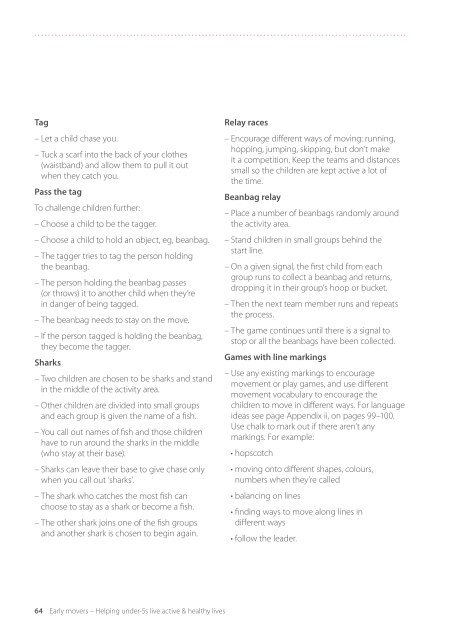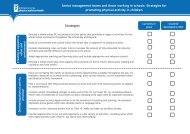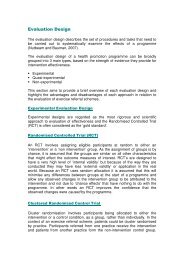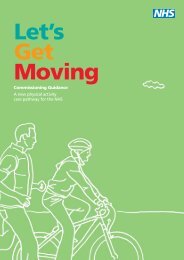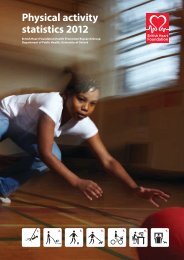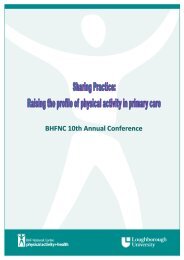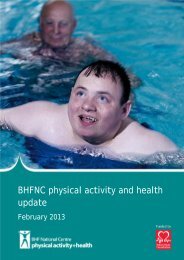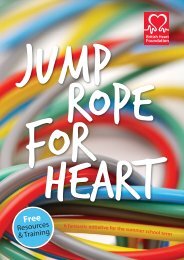5 Practical ideas for physically active play - BHF National Centre ...
5 Practical ideas for physically active play - BHF National Centre ...
5 Practical ideas for physically active play - BHF National Centre ...
- No tags were found...
Create successful ePaper yourself
Turn your PDF publications into a flip-book with our unique Google optimized e-Paper software.
TagRelay racesFollow the leaderExploring open spaces– Let a child chase you.– Tuck a scarf into the back of your clothes(waistband) and allow them to pull it outwhen they catch you.Pass the tagTo challenge children further:– Choose a child to be the tagger.– Choose a child to hold an object, eg, beanbag.– The tagger tries to tag the person holdingthe beanbag.– The person holding the beanbag passes(or throws) it to another child when they’rein danger of being tagged.– The beanbag needs to stay on the move.– If the person tagged is holding the beanbag,they become the tagger.Sharks– Two children are chosen to be sharks and standin the middle of the activity area.– Other children are divided into small groupsand each group is given the name of a fish.– You call out names of fish and those childrenhave to run around the sharks in the middle(who stay at their base).– Encourage different ways of moving: running,hopping, jumping, skipping, but don’t makeit a competition. Keep the teams and distancessmall so the children are kept <strong>active</strong> a lot ofthe time.Beanbag relay– Place a number of beanbags randomly aroundthe activity area.– Stand children in small groups behind thestart line.– On a given signal, the first child from eachgroup runs to collect a beanbag and returns,dropping it in their group’s hoop or bucket.– Then the next team member runs and repeatsthe process.– The game continues until there is a signal tostop or all the beanbags have been collected.Games with line markings– Use any existing markings to encouragemovement or <strong>play</strong> games, and use differentmovement vocabulary to encourage thechildren to move in different ways. For language<strong>ideas</strong> see page Appendix ii, on pages 99–100.Use chalk to mark out if there aren’t anymarkings. For example:• hopscotch– Demonstrate different <strong>ideas</strong> <strong>for</strong> moving around,eg, hopping, skipping, running and actions,eg, stretching up tall, clapping hands, touchingtoes. For language <strong>ideas</strong> see Appendix ii onpages 99–100.– Encourage children to be creative and to takeit in turns to be ‘the leader’ and demonstrate asmany different ways of moving and actions theycan while saying out loud what they are doing.– This can be an indoor and outdoor activity.– Use the space at your setting or in your localarea to let children experience the freedomof running around spontaneously andexperiencing whole body movement. Forprompts to encourage quality movement seethe skills card on page 87.– Explore rough grassy or woodland areaswith slopes, mounds and natural materials.Let children try some log rolls (make a longthin shape with arms above heads) downa grassy slope.– Encourage them to move in different waysand directions, stopping, following pathways,weaving around obstacles.– Let children run around with ribbons orstreamers attached to sticks on windy days.Take out a kite and/or parachute.– Plan a nature walk in the nearby area andlet children look <strong>for</strong> and collect items, eg,twigs, leaves, pine cones, pebbles etc.Encourage them to talk about what theyfind while they’re walking.– Roll hoops across an open area so childrencan practise running and catching a hoop.– Can they roll the hoop to themselves, ie, chaseafter it, and catch it be<strong>for</strong>e it falls to the ground?How far can they get their hoop to roll?– Sharks can leave their base to give chase onlywhen you call out ‘sharks’.• moving onto different shapes, colours,numbers when they’re called– The shark who catches the most fish canchoose to stay as a shark or become a fish.– The other shark joins one of the fish groupsand another shark is chosen to begin again.• balancing on lines• finding ways to move along lines indifferent ways• follow the leader.64 Early movers – Helping under-5s live <strong>active</strong> & healthy livesSection 5 – <strong>Practical</strong> <strong>ideas</strong> <strong>for</strong> <strong>physically</strong> <strong>active</strong> <strong>play</strong> 65


